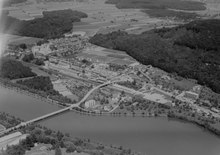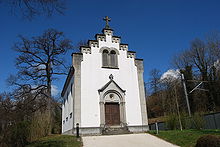Schinznach-Bad
Schinznach-Bad | |
|---|---|
 Schinznach-Bad spa park | |
| Coordinates: 47°27′N 8°10′E / 47.450°N 8.167°E | |
| Country | Switzerland |
| Canton | Aargau |
| District | Brugg |
| Area | |
• Total | 1.90 km2 (0.73 sq mi) |
| Elevation | 354 m (1,161 ft) |
| Population (31 December 2018)[2] | |
• Total | 1,347 |
| • Density | 710/km2 (1,800/sq mi) |
| Time zone | UTC+01:00 (Central European Time) |
| • Summer (DST) | UTC+02:00 (Central European Summer Time) |
| Postal code(s) | 5116 |
| SFOS number | 4114 |
| ISO 3166 code | CH-AG |
| Surrounded by | Brugg, Habsburg, Holderbank, Scherz, Schinznach-Dorf, Villnachern |
| Website | schinznach-bad SFSO statistics |

Schinznach-Bad is a former municipality in the district of Brugg in canton of Aargau in Switzerland. On 1 January 2020 the municipality of Schinznach-Bad merged into Brugg.[3]
Geography
[edit]

Schinznach-Bad has an area, as of 2009[update], of 1.9 square kilometers (0.73 sq mi). Of this area, 0.1 km2 (25 acres) or 5.3% is used for agricultural purposes, while 0.74 square kilometers (0.29 sq mi) or 38.9% is forested. Of the rest of the land, 0.86 square kilometers (0.33 sq mi) or 45.3% is settled (buildings or roads), 0.18 square kilometers (0.069 sq mi) or 9.5% is either rivers or lakes and 0.01 km2 (2.5 acres) or 0.5% is unproductive land.[4]
Of the built up area, industrial buildings made up 3.7% of the total area while housing and buildings made up 15.3% and transportation infrastructure made up 12.1%. while parks, green belts and sports fields made up 13.7%. 37.4% of the total land area is heavily forested and 1.6% is covered with orchards or small clusters of trees. Of the agricultural land, 2.6% is used for growing crops and 2.6% is pastures. All the water in the municipality is in rivers and streams.[4]
Coat of arms
[edit]The blazon of the municipal coat of arms is Azure two Mullets Or and between them in chief a Crescent of the same and in base three barrulets wavy Argent.[5]
Demographics
[edit]Schinznach-Bad has a population (as of December 2020[update]) of 1,346.[6] As of June 2009[update], 26.4% of the population are foreign nationals.[7] Over the last 10 years (1997–2007) the population has changed at a rate of -0.5%. Most of the population (as of 2000[update]) speaks German (80.8%), with Serbo-Croatian being second most common ( 5.6%) and Albanian being third ( 2.5%).[8]
The age distribution, as of 2008[update], in Schinznach-Bad is; 106 children or 8.6% of the population are between 0 and 9 years old and 150 teenagers or 12.1% are between 10 and 19. Of the adult population, 166 people or 13.4% of the population are between 20 and 29 years old. 150 people or 12.1% are between 30 and 39, 206 people or 16.6% are between 40 and 49, and 191 people or 15.4% are between 50 and 59. The senior population distribution is 126 people or 10.2% of the population are between 60 and 69 years old, 88 people or 7.1% are between 70 and 79, there are 49 people or 4.0% who are between 80 and 89, and there are 7 people or 0.6% who are 90 and older.[9]
At the same time there were 501 private households (homes and apartments) in the municipality, and an average of 2.5 persons per household.[8]
As of 2000[update], there were 55 homes with 1 or 2 persons in the household, 250 homes with 3 or 4 persons in the household, and 190 homes with 5 or more persons in the household. The average number of people per household was 2.45 individuals.[10] In 2008[update] there were 208 single family homes (or 36.7% of the total) out of a total of 566 homes and apartments.[11] There were a total of 6 empty apartments for a 1.1% vacancy rate.[11] As of 2007[update], the construction rate of new housing units was 0.8 new units per 1000 residents.[8]
In the 2007 federal election the most popular party was the SVP which received 37.6% of the vote. The next three most popular parties were the FDP (20.3%), the SP (14.8%) and the CVP (9%).[8]
In Schinznach-Bad about 68.8% of the population (between age 25–64) have completed either non-mandatory upper secondary education or additional higher education (either university or a Fachhochschule).[8] Of the school age population (in the 2008/2009 school year[update]), there are 78 students attending primary school in the municipality.[10]
The historical population is given in the following table:[9]
| Year | Pop. | ±% |
|---|---|---|
| 1975 | 1,075 | — |
| 1980 | 962 | −10.5% |
| 1990 | 1,202 | +24.9% |
| 2000 | 1,248 | +3.8% |
Sights
[edit]The village of Schinznach-Bad is designated as part of the Inventory of Swiss Heritage Sites.[12]
Economy
[edit]As of 2007[update], Schinznach-Bad had an unemployment rate of 2.89%. As of 2005[update], there were 8 people employed in the primary economic sector and about 2 businesses involved in this sector. 152 people are employed in the secondary sector and there are 2 businesses in this sector. 944 people are employed in the tertiary sector, with 57 businesses in this sector.[8]
As of 2000[update] there was a total of 666 workers who lived in the municipality. Of these, 493 or about 74.0% of the residents worked outside Schinznach-Bad while 784 people commuted into the municipality for work. There were a total of 957 jobs (of at least 6 hours per week) in the municipality.[13] Of the working population, 15.5% used public transportation to get to work, and 50.5% used a private car.[8]
Religion
[edit]
From the 2000 census[update], 349 or 27.7% were Roman Catholic, while 509 or 40.5% belonged to the Swiss Reformed Church. Of the rest of the population, there were 2 individuals (or about 0.16% of the population) who belonged to the Christian Catholic faith.[10]
References
[edit]- ^ a b "Arealstatistik Standard - Gemeinden nach 4 Hauptbereichen". Federal Statistical Office. Retrieved 13 January 2019.
- ^ "Ständige Wohnbevölkerung nach Staatsangehörigkeitskategorie Geschlecht und Gemeinde; Provisorische Jahresergebnisse; 2018". Federal Statistical Office. 9 April 2019. Retrieved 11 April 2019.
- ^ Amtliches Gemeindeverzeichnis der Schweiz, Mutationsmeldungen 2009 / Répertoire officiel des communes de Suisse, Mutations 2009 / Elenco ufficiale dei Comuni della Svizzera, Mutazione 2009 (PDF) (Report). Federal Statistical Office. 2009. 3169. Archived from the original (PDF) on 18 November 2010. Retrieved 6 March 2010.
- ^ a b Swiss Federal Statistical Office-Land Use Statistics 2009 data (in German) accessed 25 March 2010
- ^ Flags of the World.com accessed 9 April 2010
- ^ "Ständige und nichtständige Wohnbevölkerung nach institutionellen Gliederungen, Geburtsort und Staatsangehörigkeit". bfs.admin.ch (in German). Swiss Federal Statistical Office - STAT-TAB. 31 December 2020. Retrieved 21 September 2021.
- ^ Statistical Department of Canton Aargau -Bereich 01 -Bevölkerung (in German) accessed 20 January 2010
- ^ a b c d e f g Swiss Federal Statistical Office accessed 9 April 2010
- ^ a b Statistical Department of Canton Aargau -Bevölkerungsdaten für den Kanton Aargau und die Gemeinden (Archiv) (in German) accessed 20 January 2010
- ^ a b c Statistical Department of Canton Aargau – Aargauer Zahlen 2009 (in German) accessed 20 January 2010
- ^ a b Statistical Department of Canton Aargau (in German) accessed 20 January 2010
- ^ ISOS site accessed 09-Apr-2010
- ^ Statistical Department of Canton Aargau-Bereich 11 Verkehr und Nachrichtenwesen (in German) accessed 21 January 2010





